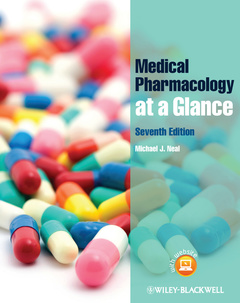Description
Medical pharmacology at a glance (7th Ed.)
Author: Michael Neal
Language: English
Approximative price 33.83 €
In Print (Delivery period: 14 days).
Add to cart128 p. · Paperback
Description
/li>Contents
/li>
Key principles are supported by coloured schematic diagrams - invaluable as both an introduction to medical pharmacology, and revision in the run-up to pharmacology exams.
Revised and thoroughly updated throughout, and reflecting changes to the content and assessment methods used by medical schools, Medical Pharmacology at a Glance:
- Introduces the basic principles of drug action, interaction, absorption and excretion
- Bases chapters on diseases and syndromes, for clinically-focused learning
- Includes references to the pathophysiology of disease, to aid understanding of drug choice and action
- Indicates the therapeutics of choice for specific disorders and conditions
- Features cross references between discussion of drug classes and diseases
- Includes self-assessment cases studies with full answers, for revision and review
- Features a new chapter on immunosuppressants and antirheumatoid drugs
Now includes abrand new companion website, with cases and fully downloadable flashcards...
How to use this book.
Further reading.
1 Introduction: principles of drug action.
2 Drug-receptor interactions.
3 Drug absorption, distribution and excretion.
4 Drug metabolism.
5 Local anaesthetics.
6 Drugs acting at the neuromuscular junction.
7 Autonomic nervous system.
8 Autonomic drugs acting at cholinergic synapses.
9 Drugs acting on the sympathetic system.
10 Ocular pharmacology.
11 Asthma, hay fever and anaphylaxis.
12 Drugs acting on the gastrointestinal tract I: Peptic ulcer.
13 Drugs acting on the gastrointestinal tract II: Motility and secretions.
14 Drugs acting on the kidney-diuretics.
15 Drugs used in hypertension.
16 Drugs used in angina.
17 Antiarrhythmic drugs.
18 Drugs used in heart failure.
19 Drugs used to affect blood coagulation.
20 Lipid-lowering drugs.
21 Agents used in anaemias.
22 Central transmitter substances.
23 General anaesthetics.
24 Anxiolytics and hypnotics.
25 Antiepileptic drugs.
26 Drugs used in Parkinson"s disease.
27 Antipsychotic drugs (neuroleptics).
28 Drugs used in affective disorders-antidepressants.
29 Opioid analgesics.
30 Drugs used in nausea and vertigo (antiemetics).
31 Drug misuse and dependence.
32 Non-steroidal anti-inflammatory drugs (NSAIDs).
33 Corticosteroids.
34 Sex hormones and drugs.
35 Thyroid and antithyroid drugs.
36 Antidiabetic agents.
37 Antibacterial drugs that inhibit nucleic acid synthesis: sulphonamides, trimethoprim, quinolones and nitroimidazoles.
38 Antibacterial drugs that inhibit cell wall synthesis: penicillins, cephalosporins and vancomycin.
39 Antibacterial drugs that inhibit protein synthesis: aminoglycosides, tetracyclines, macrolides and chloramphenicol.
40 Antifungal drugs.
41 Antiviral drugs.
42 Drugs acting on parasites I: Helminths (worms).
43 Drugs acting on parasites II: Protozoa.
44 Drugs used in cancer.
45 Immunosuppressants.
46 Poisoning.
47 Adverse drug reactions.
Case studies and questions.
Answers.
Index.
These books may interest you

Medical Pharmacology at a Glance 39.58 €

Anaesthesia at a Glance 39.58 €


